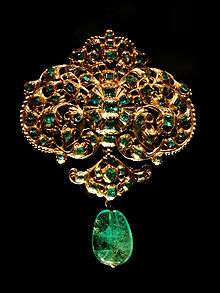Complex oxide
A complex oxide is a chemical compound that contains oxygen and at least two other elements (or oxygen and just one other element that's in at least two oxidation states).[1] Complex oxide materials are notable for their wide range of magnetic and electronic properties, such as ferromagnetism, ferroelectricity, and high-temperature superconductivity. These properties often come from their strongly correlated electrons in d or f orbitals.

Natural occurrence
Many minerals found in the ground are complex oxides. Commonly studied mineral crystal families include spinels and perovskites.
Applications
Complex oxide materials are used in a variety of commercial applications.
Magnets
Magnets made of the complex oxide ferrite are commonly used in transformer cores and in inductors.[2] Ferrites are ideal for these applications because they are magnetic, electrically insulating, and inexpensive.
Transducers and actuators
Piezoelectric transducers and actuators are often made of the complex oxide PZT (lead zirconate titanate).[3] These transducers are used in applications such ultrasound imaging and some microphones. PZT is also sometimes used for piezo ignition in lighters and gas grills.
Capacitors
Complex oxide materials are the dominant dielectric material in ceramic capacitors.[4] About one trillion ceramic capacitors are produced each year to be used in electronic equipment.
Fuel cells
Solid oxide fuel cells often use complex oxide materials as their electrolytes, anodes, and cathodes.[5]
Gemstone jewelry

Many precious gemstones, such as emerald and topaz, are complex oxide crystals. Historically, some complex oxide materials (such as strontium titanate, yttrium aluminium garnet, and gadolinium gallium garnet) were also synthesized as inexpensive diamond simulants, though after 1976 they were mostly eclipsed by cubic zirconia.
New electronic devices
As of 2015, there is research underway to commercialize complex oxides in new kinds of electronic devices, such as ReRAM, FeRAM, and memristors. Complex oxide materials are also being researched for their use in spintronics.
Another potential application of complex oxide materials is superconducting power lines.[7] A few companies have invested in pilot projects, but the technology is not widespread.
Commonly studied complex oxides
- Lead zirconate titanate (a piezoelectric material)
- Lanthanum aluminate (a high-dielectric insulator)
- Strontium titanate (a high-dielectric semiconductor)
- Lanthanum strontium manganite (a material exhibiting colossal magnetoresistance)
- Barium titanate (a multiferroic material)
- Bismuth ferrite (a multiferroic material)
- Yttrium barium copper oxide (a high-temperature superconductor)
- Bismuth strontium calcium copper oxide (a high-temperature superconductor)
See also
References
- Ishihara, Tatsumi (2009). Perovskite Oxide for Solid Oxide Fuel Cells. Fuel Cells and Hydrogen Energy (1 ed.). Springer US. p. 1. doi:10.1007/978-0-387-77708-5. ISBN 978-0-387-77708-5.
- Goldman, Alex (2006). "Applications and Functions of Ferrites". Modern Ferrite Technology (2nd ed.). Springer US. pp. 217–226. doi:10.1007/978-0-387-29413-1_8. ISBN 978-0-387-28151-3.
- "What is "PZT"?". American Piezo. APC International, Ltd. Retrieved 19 June 2015.
- Ho, J.; Jow, T. R.; Boggs, S. (2010). "Historical introduction to capacitor technology". IEEE Electrical Insulation Magazine. 26: 20–25. doi:10.1109/MEI.2010.5383924. Archived 2016-12-05 at the Wayback Machine
- "Lanthanum strontium cobalt oxide cathode powder". Fuel Cell Materials. Retrieved 19 June 2015.
- "Pendant | V&A Search the Collections". Victoria and Albert Museum. Given by Dame Joan Evans. Retrieved 30 Jan 2014.CS1 maint: others (link) Museum item number M.138-1975
- "Superconductor cable systems". AMSC.